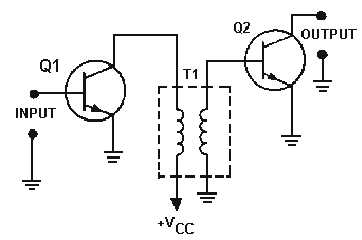1-14
Figure 1-12.—Transformer-coupled transistor amplifier.
The inductors that make up the primary and secondary of the transformer have very little dc
resistance, so the efficiency of the amplifiers is very high. Transformer coupling is very often used for the
final output (between the final amplifier stage and the output device) because of the impedance-matching
qualities of the transformer. The frequency response of transformer-coupled amplifiers is limited by the
inductive reactance of the transformer just as it was limited in impedance coupling.
Q-12. What is the purpose of an amplifier-coupling network?
Q-13. What are four methods of coupling amplifier stages?
Q-14. What is the most common form of coupling?
Q-15. What type coupling is usually used to couple the output from a power amplifier?
Q-16. What type coupling would be most useful for an audio amplifier between the first and second
stages?
Q-17. What type of coupling is most effective at high frequencies?
IMPEDANCE CONSIDERATIONS FOR AMPLIFIERS
It has been mentioned that efficiency and impedance are important in amplifiers. The reasons for this
may not be too clear. You have been shown that any amplifier is a current-control device. Now there are
two other principles you should try to keep in mind. First, there is no such thing as "something for
nothing" in electronics. That means every time you do something to a signal it costs something. It might
mean a loss in fidelity to get high power. Some other compromise might also be made when a circuit is
designed. Regardless of the compromise, every stage will require and use power. This brings up the
second principle-do things as efficiently as possible. The improvement and design of electronic circuits is
an attempt to do things as cheaply as possible, in terms of power, when all the other requirements
(fidelity, power output, frequency range, etc.) have been met.
This brings us to efficiency. The most efficient device is the one that does the job with the least loss
of power. One of the largest losses of power is caused by impedance differences between the output of
one circuit and the input of the next circuit. Perhaps the best way to think of an impedance difference
(mismatch) between circuits is to think of different-sized water pipes. If you try to connect a one-inch
water pipe to a two-inch water pipe without an adapter you will lose water. You must use an adapter. A

